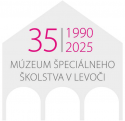Evangelic Special Boarding School for Deaf-Blind Children at Červenica, 1992
1 September 2000 the school changed its name to Evangelic Special Primary Boarding School for Deaf-Blind Children in Červenica. Since 2010 the school bears name Evangelic United Boarding School in Červenica with following departments:
Evangelic Special Boarding Kindergarden
Evangelical special primary boarding school for deafblind
Evangelical practical boarding school
Currently the kindergarten as a one-class pre-school facility provides education of 5 preschool children from 3 to 6 years requiring special care. The facility employs – special pedagogue, 2 educators and 1 assistant educator.
Length of education at the Special primary school is 10 years of daily study form. The school provides education of students who had been diagnosed with current visual and hearing disabilities of varying stages associated with other disabilities. The school is attended by 12 students from all over Slovakia. Classes are held in three classrooms and is provided by three teachers, one educator, two teaching assistants and 2 assistant educators.
Education of deafblind students is characterized by customized education. Program of the day is divided into regular rotation of teaching, rest and play, which are consistent with capabilities of students. Also the separate morning classes are interrupted by the moments of relaxation or breaks. Length of the time taught and class is individual. It may take 5 to 30 minutes. It depends on the momentary psychological and physiological capabilities of the student.
The main role of the Practical school is education connected with effort of reaching the most possible application of students. After the third year of study, the clients are prepared to handle the demands of everyday needs and self-servicing at home with the help of another person. The educational process is aimed at three departments:
Construction works
Gardening
Food preparation and nutrition
There is 6 clients being educated at the school during the 2016/17 school year.
Among the most famous educated deafblind personalities belong: Laura Bridgman, Helen Keller and Olga Skorochodovova.
The first beginnings of education of the deafblind are within the period of the year 1837, when first successfully systematically educated deafblind person became Laura Bridgman. Her education with visible and lasting progress disproved then prevailing idea that deafblind individuals are un-teachable. Laura Bridgman acquired visual and hearing impairment, as well as loss of smell and taste as a result of overcoming scarlet fever in early childhood.
She stopped talking on the basis of lack of hearing control, she lost the ability to control her articulation and tongue and the sound did not correspond with the idea. Her initial communication was at the level of gestures and signals, in the form of a pat on the head, back, shoulder, smacking and dragging from place to place. She began to use her own natural language in which she had designated special gesticulation for each family member. This communication was obviously insufficient because it applied only to specific people, objects and situations. It did not allow her to communicate more broadly, to receive a sufficient amount of desired information, which caused misunderstanding of the world around her, its metamorphoses and laws governing the nature and its elements. Unrecognizable naming of the things led to a lack of vocabulary and the subsequent inability to justify and explain anything.
This deficit began to have a major impact when she was seven and by the means of behavioral problems and aggression which were aimed at the surroundings – misunderstood surroundings.
Her special education began on 4 October 1837, when Laura was taken to Perkins Institute for the Blind in Boston, Massachusetts, USA. The system of education was very suitable for her because it was based on her absolutely necessary and particularly sensitive touch, which allowed her to receive information in the form of vibration, touch, motion and air flow. She was being educated through Howe relief alphabet (later known as the Boston and finally New York font), with the individual pre-printed letters on a metal substrate to a certain depth and height. Later the education was done through dactyl (finger) alphabet, which is also used by the deaf. The main idea of this alphabet is the position of the fingers of one or both hands, which are used to express individual letters (sounds) of the alphabet. She learned to write handprinting using boards with grooves which then became her most widely used means of communication. Thanks to the combination of letters she could express any of her thoughts, moods and states.
Her educational program ended when she was 23 years old. She achieved knowledge of geography, history, physical education, religion, astronomy, philosophy and music. She has acquired new and enhanced already acquired skills: sewing, knitting, crochet, housework. She has also adopted a code of good behavior. For her whole life she led a correspondence, wrote three poems, read the Bible and books written embossed font for the blind and later she herself assisted in the education of deafblind children and became their emotional support.
Source:


